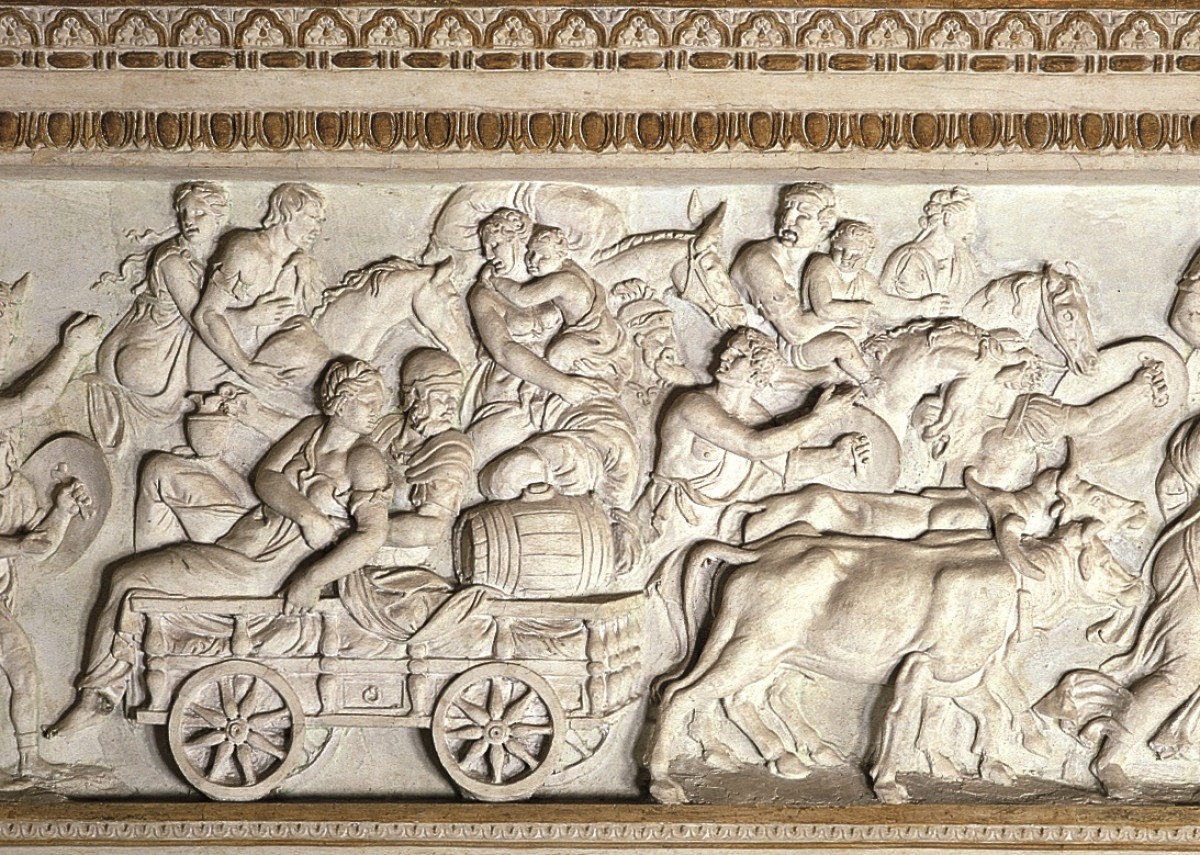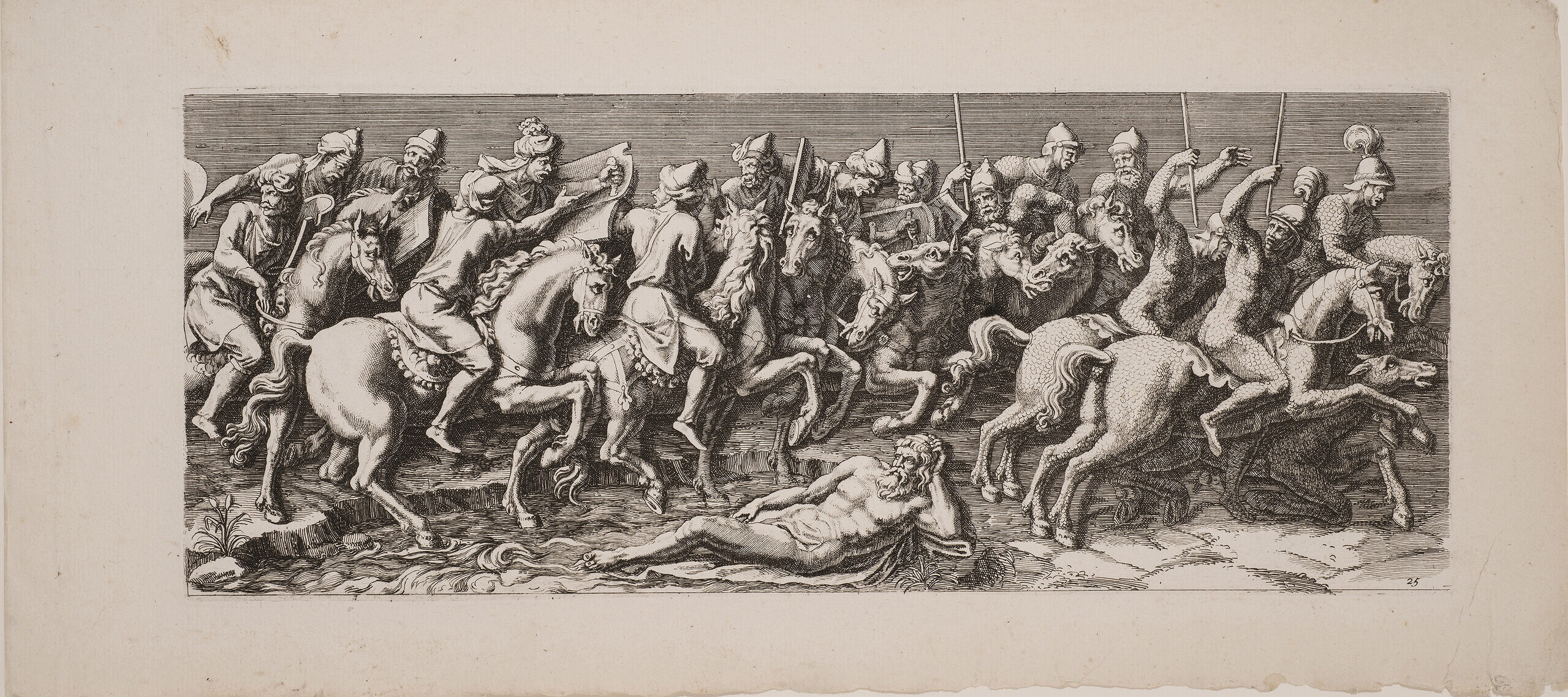At the National Museum of Women in the Arts in Washington DC is an unexpected exhibition titled Impressive: Antoinette Bouzonnet-Stella (on through October 20, 2024). Ranging across the blue walls of three adjacent alcoves, a series of twenty-five 17th-century prints by artist Antoinette Bouzonnet-Stella (Lyon,1641-Paris,1676) depicts The Entrance of the Emperor Sigismond into Mantua (1675).
The 25 relief-style engravings on paper teem with horses and oxen pulling wagons, children and women follow men brandishing spears, musicians, river gods and soldiers traveling in the entourage of the Emperor. The lively and exacting detail in the engravings is pure delight.

Impressive: Antoinette Bouzonnet-Stella, Installation view
The exhibition explores the circumstances of the creation of the series, and focuses on the artist’s life in Paris. At age 13, Antoinette Bouzonnet (1641-1676) moved with her siblings from Lyon to Paris, to live and work with her uncle, artist Jacques Stella, in his prestigious lodgings in the Louvre.
By the time Antoinette and her siblings joined his Paris workshop, Jacques Stella was an established painter and printmaker, and a leading proponent of the neoclassical style. He had lived in Florence from about 1616 to the early 1620s, working for Cosimo II de’ Medici and absorbing Italian Renaissance classicism. Following Cosimo’s death in 1621, Stella moved to Rome, where he lived for 10 years producing well-regarded small-scale paintings and engravings. There he met Nicolas Poussin and was deeply influenced by his art. Stella became one of Poussin’s few close friends.
Stella had previously come to the attention of Cardinal Richelieu, and when he arrived in Paris in about 1634, Richelieu presented him to Louis XIII, who appointed him Painter to the King. At the time there was an all-out effort by the French government to emulate Classical Greek and Roman aesthetics in French art, and Stella’s training in Italy stood him in good stead with this program.
Once Antoinette had settled into her uncle’s household, she adopted his name, adding it to her own surname. Under Stella’s tutelage she mastered various techniques of printmaking and collaborated with her sisters in copying paintings by both their uncle and Poussin. As her reputation grew, in time Antoinette also received her own commissions. In 1675 she executed The Entrance of the Emperor Sigismond into Mantua for Louis XIV’s minister of finance. These exquisitely executed engravings demonstrate how classical art, borrowed from antiquity, was rebirthed in 16th-century Italy and sought by the 17th-century French court to create a strong national art.

Just one year after this monumental series was completed, Antoinette Bouzonnet-Stella suffered an accidental fall and died in Paris at the age of 35.
The imagery of this series of prints is taken from a 16th-century Italian Renaissance stucco frieze designed by Giulio Romano for the Palazzo del Te in Mantua, which itself had been modelled on the 2nd-century style of Trajan’s Column in Rome. How this was accomplished is something of a mystery since it is highly unlikely that Bouzonnet-Stella travelled to Italy to see the frieze in person. However, it’s known that her uncle journeyed to Venice and Milan on his way from Rome to Paris, and Mantua is directly on the route between those two cities. Although there is no record of his having done so, it seems likely that he would have stopped to see and make drawings of the famous frieze in the Sala dei Stucchi in the Palazzo del Te.
That she was separated by a century and hundreds of miles from Giulio Romano’s frieze, makes it all the more amazing that Bouzonnet-Stella’s engravings track the frieze from left to right with such tremendous fidelity to the original.

Detail of Giulio Romano’s frieze at Palazzo del Te, Mantua 
Plate 2 from the Bouzonnet-Stella series of engravings
Palazzo del Te was constructed in the decade from 1524–1534 as a palace of leisure for Federico II Gonzaga, Marquess of Mantua, who was named Duke of Mantua in 1530. The frieze exalted the family’s history, immortalizing the glorious event when the hereditary title of marquess was bestowed by Emperor Sigismund upon Federico II’s great-grandfather, Gianfrancesco I, on 22 September 1433. The artist aggrandized the historic occasion by imagining an Imperial Roman (31 BC-476 AD) triumphal entrance into a city, placing Sigismond (1368-1437) at its center.
Apparently, even the River gods came out for the event!


Of course, the Emperor never went anywhere without his musicians (banner image) and engineers …

To find an intact set of any old series of prints is increasingly rare, as over time they have often been broken up to be sold piecemeal, often bringing in more per print than the full set would. However, in a testament to the quality of the collection of the National Museum of Women in the Arts, they hold a full set of the 25 engravings that make up Antoinette Bouzonnet-Stella’s The Entrance of the Emperor Sigismond into Mantua.
ArtGeek highly recommends this exhibition.
Hmmm … maybe it’s time to plan a little trip …
Impressive: Antoinette Bouzonnet-Stella, on through October 20, 2024
National Museum of Women in the Arts
1250 New York Ave NW, Washington, DC
202-783-5000
Art Things Considered is an art and travel blog for art geeks, brought to you by ArtGeek.art — the only search engine that makes it easy to discover almost 1700 art museums, historic houses & artist studios, and sculpture & botanical gardens across the US.
Just go to ArtGeek.art and enter the name of a city or state to see a complete interactive catalog of museums in the area. All in one place: descriptions, locations and links.
Use ArtGeek to plan trips and to discover hidden gem museums wherever you are or wherever you go in the US. It’s free, and it’s easy and fun to use!
© Arts Advantage Publishing, 2024
